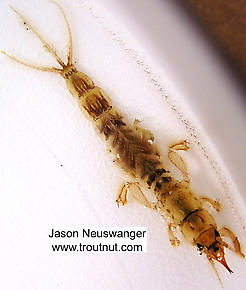Blog & Latest Updates
Fly Fishing Articles
Insects by Common Name


> > Nice pictures of accompanying Epoicocladius sp. larvae
The Specimen
Ephemera simulans (Brown Drake) Mayfly Nymph View 10 Pictures
View 10 Pictures
 View 10 Pictures
View 10 PicturesCollected January 31, 2004 from the Namekagon River in Wisconsin
Added to Troutnut.com by on January 25, 2006
Added to Troutnut.com by on January 25, 2006
The Discussion
| Beardius | August 1st, 2008, 10:54 am | |
| Posts: 19 | Several of these pictures show larvae of the midge Epoicocladius (Diptera: Churonomidae: Orthocladiinae) attached to the gills of the nymph. This species is an obligate commensal that feeds on organic material that accumulates on hair tufts at the base of the gills. They are almost always present where burrowing mayflies are present in large numbers. Different species of Epoicocladius are found on Ephemera spp., Hexagenia spp., and Litobrancha sp. | |
| Troutnut | August 2nd, 2008, 2:29 am | |
Administrator Bellevue, WAPosts: 2737 | Thanks, Beardius. That's really cool. What luck to have an expert on those midges run across my picture! | |
| Jason Neuswanger, Ph.D. Troutnut and salmonid ecologist | ||
| Beardius | August 8th, 2008, 10:23 am | |
| Posts: 19 | What luck to find such nice pictures with the Epoicocladius larvae still attached! I was delighted to see them. | |
| Beardius | August 8th, 2008, 10:46 am | |
| Posts: 19 | One more thing...keep your eyes open for midges associated with Acroneuria, Paragnetina, Pteronarcys, Nigronia, Corydalus, Epeorus, and Ephemeridae (Litobrancha, Hexagenia, Pentagenia, Ephemera). There are a lot of parasitic and commensal midge species in the genera Nanocladius and Epoicocladius that are associated with these large aquatic insect species. Many of these species are currently undescribed, though I am in the process of describing many of them. A Pitt student recently discovered the habitat and larval stages of another midge genus, Tricochilus, as living inside mussels and feeding on their glochidia (baby mussels). The habitat, larval, pupal, and male stages of this species were unknown for about 100 years until they turned up emerging in a rearing tank for mussels. The First Fork of the Sinnemahoning, Kettle Creek, Hick's Run, Pine Creek, and other north central PA streams have a lot of these associations for some reason. Anyway, I'd love to be up north collecting aquatic insects and fishing the evening hatches. Tight lines. | |
Quick Reply
You have to be logged in to post on the forum. It's this easy:
Related Discussions
| Title | Replies | Last Reply |
| Re: This is not Ephemera simulans In Hexagenia limbata Mayfly Nymph by Beardius | 1 | Aug 2, 2008 by Troutnut |
| Re: "little black caddis"--wings? In Fly Tying by CaseyP | 11 | Aug 3, 2009 by Martinlf |
| Re: Hex nymph behavior In the Mayfly Species Hexagenia limbata by Millerpa | 9 | Dec 5, 2008 by Beardius |
| Re: chironomids-East versus West In Male Stictochironomus Midge Adult by Joec | 3 | Aug 12, 2012 by Taxon |
| Re: tricos and bamboo (ok and graphite, too) In Fishing Reports by Gutcutter | 6 | Aug 21, 2010 by Gutcutter |
| Re: Your favorite hatches? In General Discussion by Troutnut | 13 | Sep 24, 2006 by Troutnut |
| Re: Emergence period of green drakes In the Mayfly Species Ephemera guttulata by Beardius | 5 | Dec 5, 2008 by Beardius |
| Re: One of my hydropower dam projects just blew out! In General Discussion by Jmd123 | 3 | May 19, 2020 by Jmd123 |
| Re: Hex in NC??? In the Identify This! Board by CalebBoyle | 4 | May 24, 2007 by CalebBoyle |
| Re: Biggest Mayfly In the Identify This! Board by Al514 | 3 | Sep 17, 2007 by Troutnut |
Troutnut.com is copyright © 2004-2024 Jason
Neuswanger (email Jason). See my FAQ for information about use of my images.
 privacy policy
privacy policy

